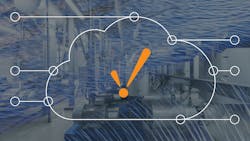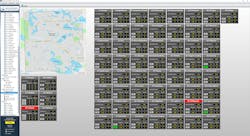Some municipalities may be hesitant to put all of their SCADA information on a cloud server off-premises, said Kevin Finkler, software engineer at Perceptive Controls.
However, in 2018, the Waterford Township Department of Public Works (aka the DPW), led the charge to put their SCADA information on an Amazon cloud server. This makes the DPW, to Perceptive’s knowledge, one of the first municipal departments to set up a cloud-based control system.
In 2015, Perceptive Controls began working with the DPW in Oakland County, Michigan, to replace their aging core SCADA infrastructure. The department was using two GE iFix workstations using a custom poll/response protocol to monitor dozens of RTUs in a round-robin fashion. Waterford manages 715 miles of water and wastewater sewer pipe, including 63 sewer lift stations, 11 treatment plants, three storage tanks and 19 production wells.
The DPW began upgrading field devices and SCADA system hardware. However, the replacements did not address some of the department’s ongoing issues. With the department’s serial polling scheme and the limited bandwidth of the radio network, data from each site could only be updated every three to four minutes. Since a lift station can run completely in under that time, operators could miss an entire cycle, Finkler said.
In 2018, Waterford decided to adopt MQTT to handle their data transmission and was in the process of installing fiber connections in all of their stations. However, Waterford’s legacy SCADA system was unable to work with MQTT. That’s when Perceptive persuaded the DPW to consider Inductive Automation’s Ignition to manage its MQTT infrastructure and integrate seamlessly with its field devices.
This was the first time Finkler had used MQTT on such a wide scale, with each individual controller reporting to the SCADA controller, he said. The project has allowed the DPW system to go from multi-minute cycles to sub-second latency.
“There is such low latency; the typical polling scheme that is the industry standard is incredibly slow by comparison,” Finkler said. “I would like to see more municipalities using Ignition or SCADA projects in general utilize MQTT for communication.”
The DPW upgraded its radio network to 4G LTE cellular modems. To add security protection, the modems were firewalled to only permit specific IP addresses to connect. DPW also uses Ignition’s support for TLS encryption and certificates of trust to establish secure connections with each EPIC.
Ignition worked well, Finkler said. “The biggest thing to say about Ignition is everything connected right up and worked flawlessly,” he said.
This was also Perceptive’s first big project that used the Ignition Perspective Module. “(The DPW) really liked that because all of their technicians in the field use iPads to pull up the Perspective project to log into the station,” Finkler said. “Then back at the main facility they have a giant widescreen monitor that has an overview of all the stations. They can see clear across the room if any station is having an issue.”
The DPW now has access to more data than ever. At the same time, travel costs are saved since Perspective can do all programming through a secure remote connection, and support costs decreased by $10,000.
The project, which is now at 54,000 tags and counting, will be completed by late 2021.

